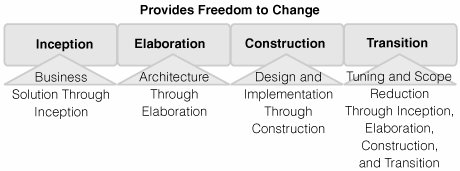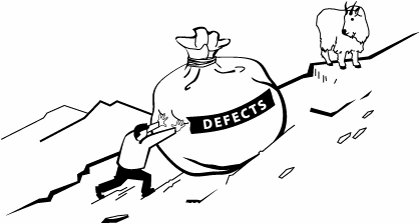Practice 3. Embrace and Manage Change
| Per Kroll Embracing change helps you to build a system that addresses stakeholder needs, and managing change allows you to reduce costs and improve predictability. ProblemPhysical systems, like bridges and skyscrapers, are very difficult to change. Adding a lane to a bridge or expanding a building is extremely costly once construction has begun. For this reason, detailed planning is critical to the success of physical engineering projects. Software, however, can be changed far more easily. Software can be designed to be configured. Early prototypes can demonstrate behavior, which can then be modified for the final system. Rather than try to design software in detail up front, it is often far better to build some software and use the working product as a communication medium to help determine what is really needed.
Nevertheless, although the ability of software to support changes provides a great opportunity to evolve it to meet changing stakeholder requirements, continuous change presents a challenge to software development teams. Changes can introduce costs that need to be managed. They can also cause developers to thrash around, unable to progress with the software because the requirements are changing faster than they can keep up. This practice describes how to manage change and keep chaos at bay while embracing necessary and important changes. BackgroundMy wife and I are currently in the middle of a garden and house renovation project. We started by writing down a rough sketch of what we wanted to have donea new deck, a large balconyand some rough ideas for landscaping our garden. We discussed the project with a few different contractors, asking each to come up with a design. We picked one design (with an associated price tag), and worked with that contractor to refine it to our exact requirements. The contractor was very open to making whatever changes we wanted to ensure that we would be happy with the end result, and we threw around a lot of ideas, while sticking to the overall agreed-upon price. As the project progressed, we ran into unexpected problems. We did not get a permit for building as large a balcony as we wanted, so we needed to change the plans and design a smaller one. Then, once we changed the structure of the balcony, we decided to alter slightly the dimensions and placement of our deck. At a later stage, our neighbors insisted we plant a few trees as a condition for their approval of the construction of our balcony. All these changes were reasonable, as they did not alter the fundamental parameters of what we were trying to achieve, but some resulted in changes that needed to be approved by all stakeholders, that is the contractor, my wife, and me. For these the contractor produced a "change order," describing in one or two sentences what revisions were being made to the original plan, which we all signed. Sometimes the change order meant a revision to the overall cost of the project, sometimes it did not; but it ensured that we all agreed on what needed to be changed. As the construction and landscaping project progressed, other, more minor issues needed to be resolved, such as what flowers to plant, exactly where to put plants, what type of stain to use on the deck, and so on. Most of these decisions could be handled without a change order, but for all major revisions we used a change order, not only to make sure that we all agreed on the changes but also to allow us to go back later and understand the end result. Sometimes my wife and I wanted changes that would have been very expensive. When we first saw the size of the deck, after it was almost completed, we felt that we had gone overboard with the size. Maybe we should have more grass, and less deck. A quick discussion with the contractor made us realize the cost of introducing such a change so late in the project. We decided that we should move ahead with the plans as they were. Project members need to have the guts to inform a customer honestly of the impact of a change (see Figure 2-4). Figure 2.4. Some Changes Can Be Very Costly.The Swedish navy launched a new grand royal flagship, Vasa, in 1628. The Swedish king asked the builder to add a second gun deck after the project was initiated. Nobody dared to tell the king about the associated risk, even though those involved knew that this change would make the ship too top-heavy to be seaworthy. The Vasa sank on its maiden voyage. Always remember to provide your customer with reliable information about the potential impact of a change.
Running a project like the one above is similar in many ways to running a software project. So what can we learn from the above?
Applying the PracticeIn this practice we will walk through concrete guidelines allowing you to embrace and manage change more effectively. We will first look at different types of change and their associated cost profile and then examine how the Unified Process lifecycle can help you to manage change. We will describe how to adapt the process of managing change to the characteristics of your project and the phase you are in. We will then review some techniques to maximize change freedom, provide guidelines for reducing thrashing by minimizing change within an iteration, and explain how to increase productivity by fixing defects as they are found, rather than maintaining a backlog of defects to be fixed sometime in the future. Let's take a closer look at these topics! Understand the Cost Profile of Different Types of Changes
Different types of changes have a different cost based on when in the project they occur, and it is important to understand the cost profiles when prioritizing project work to avoid costly changes at a late stage. Let's look at some examples.
Focusing early iterations on building the prototypes, developing and testing key capabilities, and achieving close collaboration with stakeholders will reduce the likelihood of costly shifts in direction late in the project.
The Unified Process Lifecycle and ChangeThe phases in the Unified Process lifecycle are designed to force the costly changes discussed in the previous section to occur early (see Figure 2.5), while allowing you to make critical decisions as late as safely possible, as discussed in the section Techniques Maximizing Change Freedom. Figure 2.5. Phases Are Optimized to Minimize Overall Cost of Change.The cost of introducing a change varies according to the lifecycle phase, and each type of change has its own cost profile. The Unified Process lifecycle is optimized to minimize overall cost of change, while maximizing the freedom to make changes. In general, as the project progresses, you should be more careful about introducing change, especially to the overall business solution and the architecture.
The above guidance should not be interpreted as preventing you from carrying out the necessary changes in a later phase than desired. For example, if you notice during Construction that you need to rethink the business solution and make extensive changes to the requirements to be able to deliver a satisfactory application, naturally you should consider implementing that change. But during Inception, you would not really think twice about it. If you need to change the business solution during Construction, it is reasonable to consider the following actions:
Adapt the Change Management Process Suited to the Phase and Project Type
For some applications, the cost of making any type of late change can be quite prohibitive. Consider the following:
In the section Understand the Cost Profile of Different Types of Changes we also saw that major changes late in the project, especially to the business solution and the architecture, can be particularly costly. The above are examples of project types for which you need to formalize changes late in the project. So how should you go about formalizing the decision to make a change? Change approvals are carried out through a combination of manual procedures (for example, through Change Control Boards), and through tools such as Configuration and Change Management software. Early in the project, you should ensure that the right stakeholders are aware of the change. This may require nothing more formal than an e-mail going out to appropriate stakeholders, or frequent demonstrations of working software to the stakeholder that allow you to show the changes already made and mention future planned changes, providing stakeholders with the ability to interject if they so desire. For larger and more formal projects, you may need to set up separate meetings to ensure proper handling of issues requiring contract renegotiations, or to guarantee that the right procedure is being followed from an auditing perspective due to FDA[20] or other regulations.
As projects near the end, you often want to make sure that you properly assess the potentially negative impact of any changes. For small projects, for example, a quick daily meeting may suffice to discuss major changes briefly and enable each team member to express any concerns. Larger projects, or projects requiring more formality, may instead leverage a Change Control Board with representatives from all key constituencies. This board discusses potential changes to make sure that the board members understand the pros and cons of any change. The board will then agree on whether or not to carry out the change.
Through configuration and change management tools, you can set up rules governing what changes can be made and by whom, and what process these changes need to follow. As an example, you may specify in your change and configuration management tooling that all defect fixes in the Transition phase require approval by a certain board or person before they can be included in a build. Techniques Maximizing Change FreedomThe underlying assumption with iterative development is that the only way to build the right application is by getting feedback and then making changes to the solution to accommodate this feedback. Even though changes late in the project can be costly, you want to maximize your ability to accommodate change. Here are some techniques proven to maximize change freedom:
Minimize Changes to the Current Iteration
As you work in an iteration, you will get a lot of good feedback on capabilities that you should change, and you will realize how you can do things better. You need to be very careful about introducing changes within an iteration, which may lead to churn and thrashing, thus preventing successful completion of the iteration. Here are some guidelines to consider:
Avoid Carrying Many Defects ForwardAs you develop your application, you will find a lot of defects. There will always be pressure from various stakeholders to focus on developing new capabilities rather than fixing existing defects. This is true within a project, since spending time on fixing defects from previous iterations will prevent you from developing new demonstrable features in the next iteration. It is also true that if your next project focuses on fixing defects, you will deliver fewer new features.
Each defect needs to be documented and managed. The more defects you have, the more time you spend triaging them, explaining to people how to work around them, and discussing whether they should be addressed or not. Carrying many defects forward will thus seriously impact your productivity (see Figure 2.6). To avoid wasting tons of time managing them unproductively, fix defects as you find them, rather than carrying them forward. Many teamsor rather, team leaders, customer representatives, or stakeholdersmake the common mistake of not doing this when prioritizing what is to be done. It is the responsibility of the development team to articulate the cost of carrying defects forward, but in the end whether to focus on defects or new features is a business decision. Figure 2.6. The Cost of Defects.The more defects you have, the more costly it is to triage them and bear the cost of describing to people how to work around them through support and other means. You should therefore strive to minimize your defect backlog. Fixing defects may temporarily reduce your ability to develop new features but will improve productivity over time. Comparison with Other MethodsTraditional waterfall development aims to minimize the need for changes through detailed initial specification of requirements and design and thorough subsequent review of those specifications. However, many changes are in fact triggered when stakeholders see partial implementations, rather than through careful review of specifications, and meaningful feedback therefore often comes very late in waterfall projects. Consequently, waterfall development solves problems as they were understood at the beginning of the project. Because change is discouraged, you often have to wait until the next version of the application to incorporate very important changes. Especially when combined with heavy documentation and design approaches, waterfall development often leads either to systems that poorly address user needs, or to expensive cost and schedule overruns.
Scrum focuses on several techniques consistent with this practice. Scrum proposes iterative development in which the most essential capabilities are implemented and tested in early iterations; at the same time it strongly discourages changes during an iteration (called Sprint in Scrum). Changes are captured in a product backlog and high-priority changes for each iteration are included in the Sprint backlog (compare iteration plan in Unified Process). Scrum, however, lacks distinct phases guiding the team in how to think about what type of changes to make at what time, nor does it include concepts such as Change and Control Boards. Further, Scrum does not provide techniques for how to manage and automate change, understand the impact of change, or deal with refactoring. XP provides guidance and has helped drive evolution around many of the specific techniques mentioned in this practice, including refactoring, keeping things simple, and avoiding carrying defects forward. Beck describes how these techniques help change the cost equation around change.[25] Many people have translated this to mean that with XP, the cost of change is constant, allowing changes at any time in a project. Several reviewers have heavily criticized some aspects of this practice. We strongly believe that agile practices can improve the cost equation and enable more types of change to be carried out later in most projects, but it is also important to understand that some types of changes will be increasingly costly for some projects, as outlined in this practice, especially those related to business solutions or architecture.
Levels of AdoptionThis practice can be adopted at three levels:
Related Practices
Additional InformationInformation in the Unified ProcessOpenUP/Basic provides guidance for the basic and intermediate levels of this practice. RUP also adds guidelines for the advanced practices, with guidelines and tool-specific information on configuration-and change-management practices such as parallel and distributed development, as well as information about change control boards and other more formal ways of managing change. Additional ReadingTo understand how the phases in the Unified Process lifecycle help you minimize overall cost of change, see the following:
For other practices that help drive down the cost of change, see the following:
|
EAN: 2147483647
Pages: 98
- Chapter V Consumer Complaint Behavior in the Online Environment
- Chapter VII Objective and Perceived Complexity and Their Impacts on Internet Communication
- Chapter VIII Personalization Systems and Their Deployment as Web Site Interface Design Decisions
- Chapter XVII Internet Markets and E-Loyalty
- Chapter XVIII Web Systems Design, Litigation, and Online Consumer Behavior


